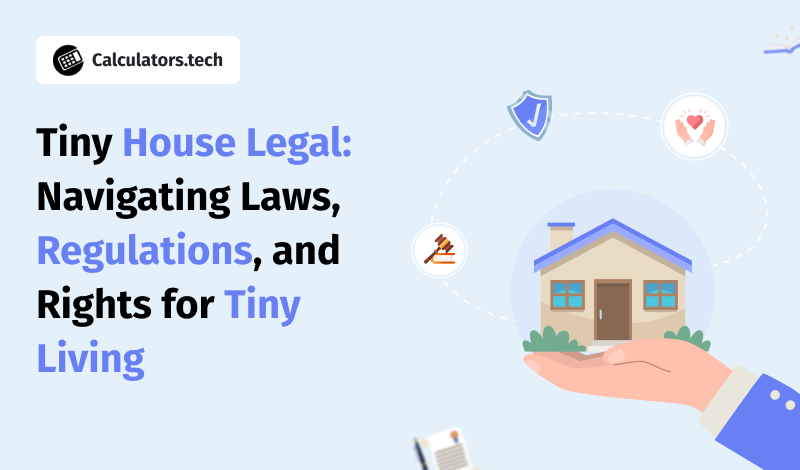The tiny house movement has captured the imagination of people worldwide who are seeking freedom, affordability, and sustainability. Yet, one of the most pressing challenges for aspiring tiny homeowners is understanding the legal framework surrounding these small dwellings. From zoning codes to building regulations, the legal landscape can be complex and varies significantly depending on location.
This guide provides a comprehensive look at tiny house legality, exploring everything from zoning laws and building codes to strategies for compliance and advocacy for legal reform.
Why Legal Matters for Tiny Houses
The charm of tiny living lies in its simplicity. However, legal questions often complicate the dream. Many individuals discover that building or parking a tiny home without proper legal groundwork can lead to problems such as fines, eviction, and even difficulties in resale. Understanding the legal context ensures that your investment, lifestyle, and rights are protected.
The Legal Definition of a Tiny House
Legally, a tiny house may fall under several categories:
Tiny House on Wheels (THOWs)
Classified similarly to RVs or mobile homes, THOWs are typically registered as trailers with the DMV and governed by recreational vehicle standards.
Tiny House on a Foundation
These are viewed as traditional residential structures. They must comply with local building codes and require permits, inspections, and in some areas, adherence to minimum square footage requirements.
Accessory Dwelling Units (ADUs)
ADUs are small, secondary units on properties with an existing home. They are subject to ADU regulations, especially in states like California, Oregon, and Washington.
Zoning Laws and Land Use Regulations
Zoning laws dictate where you can place your tiny home. Unfortunately, most zoning codes were developed before the tiny house movement gained popularity, meaning they often restrict tiny living.
Common Zoning Challenges
- Minimum square footage requirements.
- Single-family dwelling restrictions.
- Prohibitions against mobile homes.
- Time limits on RV living.
Zoning-Friendly Options
- Rural or agricultural zones with fewer restrictions.
- Planned tiny house communities.
- ADU zoning in supportive states.
Tip: Always check with your local planning or zoning department before purchasing land or parking your tiny home.
Building Codes and Safety Standards
Building codes protect safety but can present challenges for tiny houses.
Common Code Issues
- Ceiling height requirements.
- Restrictions on stairs or ladders.
- Plumbing and electrical system regulations.
- Foundation requirements.
Emerging Solutions
- IRC Appendix Q: Introduced in 2018, it provides special provisions for tiny houses under 400 square feet, covering lofts, ceiling heights, and emergency exits. Adoption is expanding nationwide.
Tiny House Legal Guidelines
Understanding and following Tiny House Legal Guidelines is crucial for anyone planning to own, build, or live in a tiny home. These guidelines involve complying with local codes on size, placement, and classification, working with certified builders such as those approved by RVIA, ANSI, or local authorities, and ensuring that Tiny Houses on Wheels (THOWs) are properly registered with the DMV.
They also cover meeting essential safety and utility standards, securing land use agreements or ownership rights, and choosing insurance providers that specifically recognize tiny homes. By applying these Tiny House Legal Guidelines, homeowners can protect their investment, avoid legal disputes, and contribute to the wider acceptance of tiny houses as a recognized and sustainable housing option.
Financing and Insurance Legalities
Legal recognition also impacts financing and insurance.
Financing Challenges
- Mortgages are often unavailable for tiny homes.
- RV loans may apply but come with high interest.
- Personal loans are common but shorter term.
Insurance Barriers
- Homeowners insurance may not apply.
- RV insurance may only apply to certified THOWs.
- Specialty insurers are slowly emerging.
Where Tiny Houses Are Legal in the U.S.
Some states and municipalities are more progressive:
- California: Strong ADU laws.
- Oregon: Recognizes tiny houses on foundations.
- Texas: Some towns, like Spur, welcome tiny houses.
- Colorado: Growing tiny home communities.
- Maine: Statewide adoption of Appendix Q.
Purpose-built tiny house communities are also growing, providing shared amenities and legally compliant housing solutions.
International Perspectives on Tiny House Legality
Globally, the situation varies:
- Canada: Progress in provinces like British Columbia.
- Europe: France and Germany adapting codes.
- Australia & New Zealand: Rural off-grid homes are more accepted, but urban rules are strict.
Legal Strategies for Aspiring Tiny Homeowners
Steps to Compliance
- Research local zoning and building codes.
- Choose the right classification (THOW, ADU, or foundation).
- Apply for permits or variances if needed.
- Join a tiny house community to simplify legal hurdles.
- Work with experienced, certified builders.
- Advocate for legal reform through councils and groups.
Legal Risks of Ignoring Compliance
Avoiding permits or registration might seem convenient but risks include:
- Eviction.
- Costly legal disputes.
- Resale challenges.
- Voided insurance claims.
The Future of Tiny House Legality
The landscape is improving as more states adopt Appendix Q and expand ADU-friendly laws. Tiny house villages are increasingly seen as affordable housing solutions. The future suggests tiny houses will become more mainstream and legally protected.
Conclusion
Tiny living offers freedom, affordability, and sustainability, but success depends on navigating the legal landscape. By researching local laws, following compliance guidelines, and advocating for reform, homeowners can secure their right to live tiny. With growing legal acceptance, the dream of living small yet fully legal is closer than ever.
